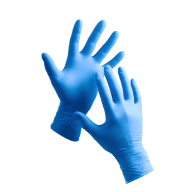Sir Safety System CFT Shoe Cover, White
Product description
Product Features:
- Made of 100% polypropylene and polyethylene film
- Fitted with taped seams
- Includes ties for secure fit
- Weight: 63 g/m²
- Pack of 50 pieces
Technical Details:
- Height: 40 cm
Measured in meters, this indicates how high the boot extends up the ankle/leg, determining protection level, ankle support, and workplace suitability.
Measured in kilograms, indicating how heavy the footwear is. Lighter shoes reduce fatigue during long shifts, while proper weight ensures adequate protection.
- Chemical Resistance
- Electrical Protection
- Antimicrobial Protection
Request a free sample
Test first and buy later. Visit any product page to request your free sample.
Standards and labels
EN 13034:2005 is a European standard that specifies the requirements and test methods for Type 6 protective clothing designed to provide protection against liquid chemicals. This standard sets criteria for the fabric's resistance to penetration by liquid chemicals and establishes guidelines for the overall design and construction of the clothing. It ensures that Type 6 protective clothing offers reliable protection for workers in industries where they may be exposed to liquid chemical hazards, but it may not be suitable for protection against airborne particles.
Test results
Liquid Chemical Protection Type 6 PBEN 13034:2005 specifies the performance requirements for protective clothing that offers limited protection against liquid chemicals, identified specifically as Type 6 PB (partial body protection). The 'Type 6 PB' designation implies that the protective garment has been tested and confirmed to provide effective defense against light spray and minor splashes of liquid chemicals, but only for parts of the body such as aprons, sleeves, or boots rather than full body suits. This standard tests the fabric's barrier effectiveness by applying a defined volume of liquid to the garment and assessing any penetration or repellence under controlled laboratory conditions. Garments achieving Type 6 PB classification are crucial for tasks in industries like chemical processing or handling where full body coverage is unnecessary, thereby offering flexibility and targeted protection, reducing the risk of chemical exposure to critical areas of the body.
EN 1149-5:2008 is a European standard that specifies the requirements for electrostatic dissipative (ESD) gloves. The standard defines performance requirements for material, design, and testing of ESD gloves. The gloves must be able to effectively discharge static electricity and protect the wearer from ESD. Testing includes measuring the surface resistance of the glove material. Pass/fail results are based on the gloves meeting or not meeting the specified requirements.
Test results
Material Performance TestedThe EN 1149-5:2008 standard specifies the performance requirements for material used in protective clothing designed to avoid incendiary discharges. The test result Tested means that the material has undergone relevant evaluation procedures to confirm its static dissipative properties. These tests generally involve measuring the electrical resistance of the material in ohms (Ω) to determine its capability to dissipate electrostatic charges and prevent sparking that could ignite flammable substances. The practical implications of this result for the respective product category (like protective workwear for use in explosive atmospheres) are significant, as it ensures that the clothing provides a level of protection against electrostatic discharges, potentially reducing the risk of fire or explosion in environments with flammable gases, vapors, or dusts.
EN ISO 9001:2015 is a standard that sets out the requirements for a quality management system (QMS). It is a set of guidelines that organizations can follow to ensure that they meet customer requirements and enhance customer satisfaction. The standard is based on the plan-do-check-act model and focuses on continuous improvement. It covers the design, development, production, installation, and servicing of products. Organizations can get certified to this standard, which means that they have been independently audited and found to meet the requirements of the standard. The certification process includes regular audits to ensure that the organization continues to meet the standard's requirements.
Test results
Service Reliability PassedISO 14001:2015 is a standard that specifies requirements for an environmental management system (EMS). It includes requirements for how companies should design, implement, maintain and improve their EMS to ensure that they minimize negative impacts on the environment and comply with environmental regulations. Test results can include information on how well the EMS is functioning, how well it is being followed, and how effective it is in reducing environmental impacts. The standard also includes requirements for how the company should document and record their EMS performance and continuously improve it.
Test results
Environmental Management PassedThe standard ISO 14001:2015 pertains to environmental management systems (EMS). A passed test result under this standard indicates that an organization's EMS meets the stringent criteria set forth for managing environmental responsibilities systematically. This ensures sustainable development while considering environmental impacts. Specifically, ISO 14001:2015 includes requirements for a framework that an organization can follow rather than establishing environmental performance criteria. It encompasses various aspects such as compliance obligations, planning actions to address risks and opportunities, and continual improvement. The test primarily involves evaluating the effectiveness of the EMS in supporting a company to achieve its intended outcomes regarding its environmental performance. If a company has passed this evaluation, it reflects their commitment to environmental stewardship, potentially enhancing their marketability and aiding in compliance with statutory and regulatory requirements.
EN 14126:1999/AC:2002 is a European standard that is an amendment of EN 14126:1999 and gives additional test methods for the evaluation of the resistance of medical clothing to penetration by infective agents. It specifies additional test methods for clothing materials and for clothing in the form of gowns and coveralls. The testing includes resistance to penetration by microorganisms, viral penetration, and resistance to penetration by blood and body fluids. Possible test results would include pass or fail based on whether the clothing meets the safety and performance requirements outlined in the standard.
EN 14605:2005 is a European standard that sets rules for how certain types of protective clothing should be tested and what requirements they must meet in order to be considered safe and effective against chemical hazards. The standard covers the test methods and performance requirements for chemical protective clothing such as coveralls, gloves, boots and overalls. The standard also sets requirement for labeling, packaging and storage of these clothing. Tests must be done to make sure the protective clothing meets the standard. If the protective clothing pass the tests, they are considered good to use.
CE Marking is a label that shows a product meets certain safety and environmental standards set by the European Union. To get the CE Marking, a company must test and certify their product meets these standards. CE Marking is required for many products sold in the EU, including electronics, machinery, toys and medical devices. It helps ensure that products are safe for consumers and the environment, and allows for easy trade within the EU.
PPE stands for "personal protective equipment." PPE Category 3 refers to equipment that is complex and provide the highest level of protection such as powered respirators, SCBA, and full body suits. In Europe, PPE Category 3 must meet certain safety standards set by the European Union, which means that it must be designed and manufactured to protect the user without causing harm. Companies that make or sell PPE must prove that it meets these standards. They also must have a quality management system in place, have to be audited regularly by a notified body and have to have a technical documentation.
SIR SAFETY SYSTEM delivery terms
Free delivery when you order more than 1 650,00 kr from SIR SAFETY SYSTEM
Supplier shipping fee 60,00 kr
Brand minimum 1 500,00 kr
655,39 kr
Price per piece
655,39 kr / piece
Shipping fee is 60,00 kr for orders under 1 650,00 kr
Sold in units of one piece
Need larger quantities?
Other products you may like
Recently viewed
Need help?
Get help from our experts
Other products you may like
Similar products you may like
Recommended for you
SIR SAFETY SYSTEM
Delivery time: 7 business days
Orders from 1 500,00 €
Supplier shipping fee 60,00 €
Free shipping on orders over 1 650,00 €



Find +150,000 products from hundreds of brands
Autonomous sourcing platform
The most efficient way to source and order supplies for your operations
Sourcing
Ordering
List products you’re looking for and we’ll find the best products and prices for you – all for free.
Need help?
Get help from our experts
